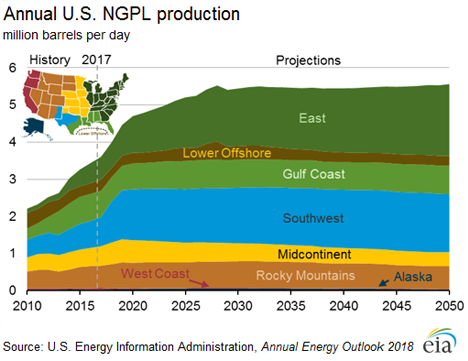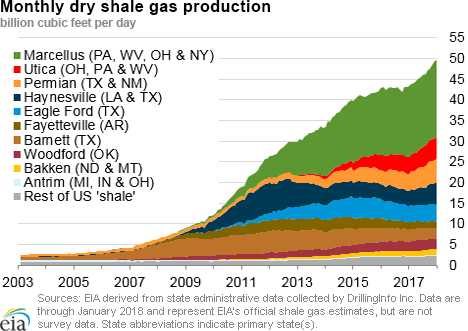In the News:
Natural gas plant liquids production reaches new annual record in 2017, with projected continued growth
Annual U.S. natural gas plant liquids (NGPL) production increased for the 12th straight year in 2017, reaching a record 3.74 million barrels per day (MMb/d), according to EIA’s February Petroleum Supply Monthly, released yesterday. Total 2017 U.S. NGPL production grew 6.4% over 2016 levels, and is double the 2007 annual production. EIA’s Short-Term Energy Outlook forecasts a 15% increase in NGPL production in 2018, which if realized would be second-highest annual increase after the 16% increase in 2014. After 2018, EIA projects a long-term growth trend in the Annual Energy Outlook 2018 (AEO2018), with NGPL production rising to 5.57 MMb/d in 2050, at the slower pace of 0.9% on average.
In general, NGPL production depends on gross natural gas withdrawals, the wet versus dry composition of this gas, and the amount of ethane that is retained in the dry gas stream, which is limited based on pipeline specifications. After 2022, EIA projects that growth in gross natural gas withdrawals will slow and the composition will become progressively drier as wetter areas, which generally yield higher NGPL production, are slowly depleted. During the same time period, EIA expects NGPL production to increase as the market for ethane expands, making ethane recovery more economic and decreasing the volumes rejected or retained in the natural gas stream. The decision to market ethane separately instead of rejecting it back into the dry gas stream depends on the relative economics of each option and the capacity to consume the ethane. EIA’s forecast increase in NGPL production between 2018 and 2022 is based on known projects coming online that will increase the capacity to make use of ethane domestically or for exports.
Because of the shifting geography of natural gas production, and the varying composition of raw natural gas produced in the different supply regions, EIA’s projections for increased NGPL production vary regionally. EIA forecasts the East region, which includes the Appalachian Basin and the Utica and Marcellus shale formations, will contribute more than 70% of incremental NGPL production growth between 2017 and 2050. The Southwest region, which includes the Permian Basin, will contribute an additional 42% of NGPL production growth. In some regions, such as the West Coast and the Midcontinent, production of natural gas and associated NGPL will decline, offsetting some of the national gains.
EIA’s projected growth in NGPL production also varies in terms of products extracted at gas processing plants. Nationally, EIA projects ethane will contribute 56% of the 1.84 MMb/d in total NGPL production growth between 2017 and 2050, with propane production growing by 25%, normal and isobutane production growing 6% each, and natural gasoline production growing by 7%.
Overview:
(For the Week Ending Wednesday, February 28, 2018)
- Natural gas spot prices fell at most locations this report week (Wednesday, February 21 to Wednesday, February 28). The Henry Hub spot price fell from $2.65 per million British thermal units (MMBtu) last Wednesday to $2.61/MMBtu yesterday.
- At the New York Mercantile Exchange (Nymex), the March 2018 contract expired Monday at $2.639/MMBtu. The April 2018 contract price decreased to $2.667/MMBtu, down 1¢ Wednesday to Wednesday.
- Net withdrawals from working gas totaled 78 billion cubic feet (Bcf) for the week ending February 23. Working natural gas stocks are 1,682 Bcf, which is 29% less than the year-ago level and 18% lower than the five-year (2013–17) average for this week.
- The natural gas plant liquids composite price at Mont Belvieu, Texas, rose by 41¢, averaging $7.91/MMBtu for the week ending February 28. The spot prices of natural gasoline, propane, butane, and isobutane rose by 3%, 8%, 5%, and 9%, respectively. The price of ethane remained flat week over week.
- According to Baker Hughes, for the week ending Tuesday, February 20, the natural gas rig count increased by 2 to 179. The number of oil-directed rigs rose by 1 to 799. The total rig count increased by 3, and it now stands at 978.
Prices/Supply/Demand:
Prices fall around the country. This report week (Wednesday, February 21 to Wednesday, February 28), the Henry Hub spot price fell 4¢ from $2.65/MMBtu last Wednesday to $2.61/MMBtu yesterday. The eastern half of the country experienced temperatures well above seasonal norms for the second week in a row. The western half of the country also saw temperatures rise week over week, but they remained below the seasonal norm.
At the Chicago Citygate, prices decreased 17¢ from $2.57/MMBtu last Wednesday to $2.40/MMBtu yesterday. Prices at PG&E Citygate in Northern California fell 57¢, down from $3.34/MMBtu last Wednesday to $2.77/MMBtu yesterday. The price at SoCal Citygate decreased $16.36 from $18.92/MMBtu last Wednesday to $2.56/MMBtu yesterday.
In Southern California, temperatures fell late last report period (covering Wednesday, February 7 to Wednesday, February 21) and remained below seasonal norms during the current report week. Southern California Gas Company’s Aliso Canyon field, which is under restricted usage following a leak in 2015, was authorized to withdraw gas three separate times this report week to help meet demand in the region. EIA provides real-time information about the Southern California region in the Southern California Daily Energy Report.
Northeast prices fall. At the Algonquin Citygate, which serves Boston-area consumers, prices went down 62¢ from $2.94/MMBtu last Wednesday to $2.32/MMBtu yesterday. At the Transcontinental Pipeline Zone 6 trading point for New York, prices decreased 1¢ from $2.71/MMBtu last Wednesday to $2.70/MMBtu yesterday.
Tennessee Zone 4 Marcellus spot prices increased 2¢ from $1.96/MMBtu last Wednesday to $1.98/MMBtu yesterday. Prices at Dominion South in northwest Pennsylvania fell 7¢ from $2.17/MMBtu last Wednesday to $2.10/MMBtu yesterday.
Nymex prices fall slightly. At the Nymex, the March 2018 contract expired Monday at $2.639/MMBtu, down 2¢ from last Wednesday. The April 2018 contract decreased steadily to $2.667/MMBtu, down 1¢ from last Wednesday to yesterday. The price of the 12-month strip averaging April 2018 through March 2019 futures contracts remained the same Wednesday to Wednesday at $2.833/MMBtu.
Supply rises slightly. According to data from PointLogic Energy, the average total supply of natural gas rose by 1% compared with the previous report week. Similarly, dry natural gas production grew by 1% compared with the previous report week. The trade press has noted that record production in recent weeks may be having a moderating effect on prices. Average net imports from Canada increased by 4% from last week.
Demand remains flat. Total U.S. consumption of natural gas was unchanged from the previous report week, averaging 75.0 Bcf/d according to data from PointLogic Energy. Natural gas consumed for power generation climbed by 4% week over week. Industrial sector consumption stayed constant, averaging 21.8 Bcf/d. In the residential and commercial sectors, consumption declined by 2%. Natural gas exports to Mexico increased by 1%.
U.S. liquefied natural gas (LNG) exports increase week over week. Five LNG vessels (LNG-carrying capacity 17.6 Bcf combined) departed the Sabine Pass liquefaction facility from February 22 to February 28. One tanker (LNG-carrying capacity 3.5 Bcf) was loading at the terminal on Wednesday.
Commissioning activities at the Dominion Energy Cove Point liquefaction facility are on-going. Although Dominion Energy does not yet report the natural gas feedstock deliveries into the terminal, according to estimates by S&P Global Platts Bentek Energy, the implied pipeline feedgas deliveries averaged 0.45 Bcf/d during the past two weeks and reached 0.8 Bcf/d on Wednesday. An LNG tanker (carrying capacity 2.97 Bcf) was docked and loading LNG at the terminal on Wednesday, with a departure likely in the next 24–48 hours.
Storage:
Working gas net withdrawals are 40 Bcf lower than the five-year average. Net withdrawals from storage totaled 78 Bcf for the week ending February 23, compared with the five-year (2013–17) average net withdrawals of 118 Bcf and last year's net withdrawals of 7 Bcf during the same week. Working gas stocks totaled 1,682 Bcf, which is 372 Bcf less than the five-year average and 680 Bcf less than last year at this time. Working gas stocks in all regions in the Lower 48 states are lower than year-ago levels.
Working gas levels are 377 Bcf above the five-year minimum. If net withdrawals from working gas stocks match the five-year average for the remainder of the withdrawal season, working gas stocks will total 1,330 Bcf by March 31, 2018, which is 22% below the five-year average, and the second-lowest reported level at the end of heating season since 2010. Working gas stocks ended the 2013–14 heating season at 837 Bcf, which is the lowest-reported level for that time.
The average March 2018 futures contract price trades at a discount to the average weekly spot price. During the most recent storage week, the average natural gas spot price at the Henry Hub was $2.65/MMBtu, 5¢/MMBtu above the front-month futures price at the Nymex.
Reported withdrawals out of storage are close to the median of analysts’ expectations. According to the Desk survey of natural gas analysts, estimates of the weekly net change in working natural gas storage ranged from 61 Bcf to 86 Bcf, with a median of 76 Bcf. Prices for the futures contract for April delivery at the Henry Hub remained unchanged, averaging $2.70/MMBtu, following the release of the Weekly Natural Gas Storage Report, with a handful of contracts traded at the release. However, prices gained 3¢/MMBtu in subsequent trading, with an unusual flurry of 1,763 trades executed more than 1 minute after the release.
Temperatures are higher than normal during the storage week throughout most of the Lower 48 states east of the Rocky Mountains. Temperatures in the Lower 48 states averaged 44 degrees Fahrenheit (°F), 6°F higher than the normal, 5°F lower than last year at this time, and 5°F above the average temperature of the prior storage week.
See also:
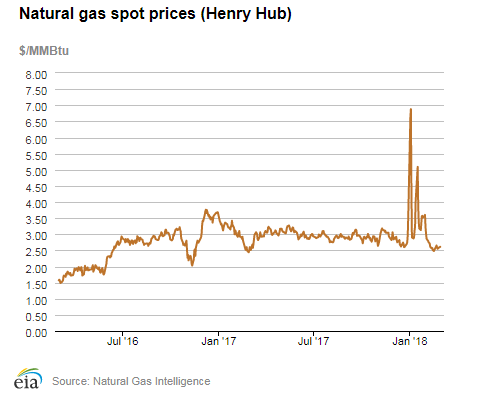
| Spot Prices ($/MMBtu) | Thu, 22-Feb |
Fri, 23-Feb |
Mon, 26-Feb |
Tue, 27-Feb |
Wed, 28-Feb |
|---|---|---|---|---|---|
| Henry Hub |
2.60 |
2.55 |
2.59 |
2.60 |
2.61 |
| New York |
2.57 |
2.45 |
2.64 |
2.57 |
2.70 |
| Chicago |
2.53 |
2.40 |
2.42 |
2.35 |
2.40 |
| Cal. Comp. Avg.* |
2.85 |
2.53 |
2.55 |
2.41 |
2.47 |
| Futures ($/MMBtu) | |||||
| March contract | 2.634 |
2.625 |
2.639 |
2.683 |
2.667 |
| April contract |
2.676 |
2.657 |
2.686 |
2.712 |
2.696 |
| *Avg. of NGI's reported prices for: Malin, PG&E Citygate, and Southern California Border Avg. | |||||
| Source: NGI's Daily Gas Price Index | |||||
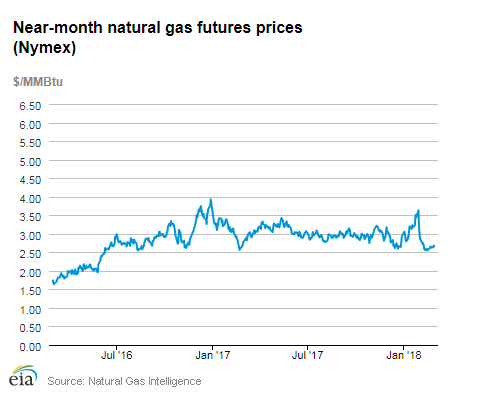
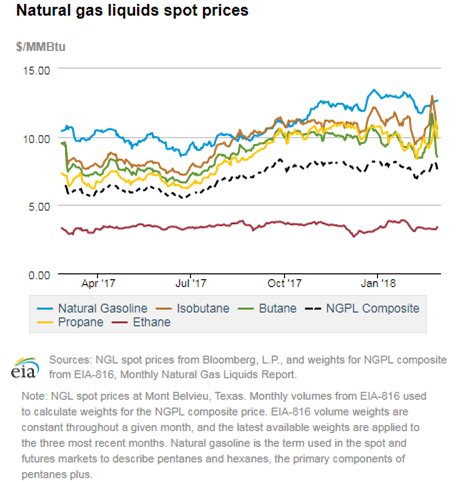
| U.S. natural gas supply - Gas Week: (2/22/18 - 2/28/18) | |||
|---|---|---|---|
Average daily values (Bcf/d): |
|||
this week |
last week |
last year |
|
| Marketed production | 88.2 |
87.7 |
79.7 |
| Dry production | 78.5 |
78.0 |
71.1 |
| Net Canada imports | 5.6 |
5.4 |
5.0 |
| LNG pipeline deliveries | 0.5 |
0.3 |
0.2 |
| Total supply | 84.6 |
83.8 |
76.3 |
|
Source: OPIS PointLogic Energy, an IHS Company | |||
| U.S. natural gas consumption - Gas Week: (2/22/18 - 2/28/18) | |||
|---|---|---|---|
Average daily values (Bcf/d): |
|||
this week |
last week |
last year |
|
| U.S. consumption | 75.0 |
74.7 |
68.9 |
| Power | 23.9 |
22.9 |
21.5 |
| Industrial | 21.8 |
21.9 |
21.1 |
| Residential/commercial | 29.3 |
30.0 |
26.3 |
| Mexico exports | 4.3 |
4.3 |
4.0 |
| Pipeline fuel use/losses | 5.9 |
5.9 |
5.4 |
| LNG pipeline receipts | 3.6 |
2.4 |
1.8 |
| Total demand | 88.8 |
87.3 |
80.2 |
|
Source: OPIS PointLogic Energy, an IHS Company | |||
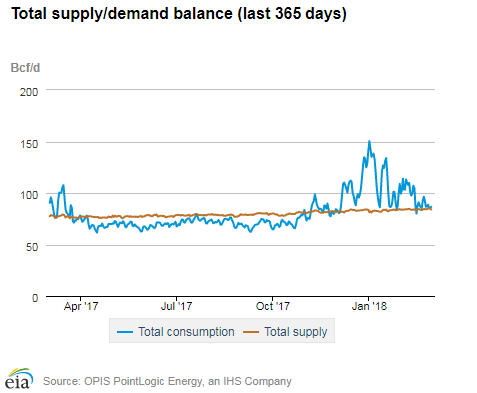
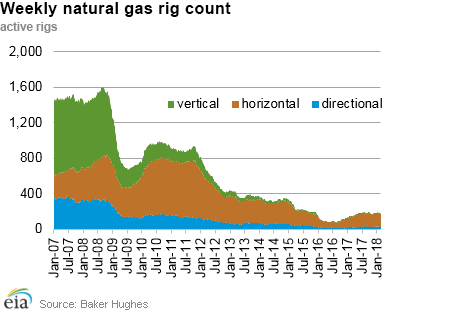
| Rigs | |||
|---|---|---|---|
Fri, February 23, 2018 |
Change from |
||
last week |
last year |
||
| Oil rigs | 799 |
0.1% |
32.7% |
| Natural gas rigs | 179 |
1.1% |
18.5% |
| Note: Excludes any miscellaneous rigs | |||
| Rig numbers by type | |||
|---|---|---|---|
Fri, February 23, 2018 |
Change from |
||
last week |
last year |
||
| Vertical | 67 |
3.1% |
9.8% |
| Horizontal | 842 |
0.4% |
34.9% |
| Directional | 69 |
-2.8% |
0.0% |
| Source: Baker Hughes Inc. | |||
| Working gas in underground storage | ||||
|---|---|---|---|---|
Stocks billion cubic feet (Bcf) |
||||
| Region | 2018-02-23 |
2018-02-16 |
change |
|
| East | 382 |
403 |
-21 |
|
| Midwest | 398 |
428 |
-30 |
|
| Mountain | 102 |
111 |
-9 |
|
| Pacific | 189 |
204 |
-15 |
|
| South Central | 611 |
614 |
-3 |
|
| Total | 1,682 |
1,760 |
-78 |
|
| Source: U.S. Energy Information Administration | ||||
| Working gas in underground storage | |||||
|---|---|---|---|---|---|
Historical comparisons |
|||||
Year ago (2/23/17) |
5-year average (2013-2017) |
||||
| Region | Stocks (Bcf) |
% change |
Stocks (Bcf) |
% change |
|
| East | 423 |
-9.7 |
413 |
-7.5 |
|
| Midwest | 609 |
-34.6 |
488 |
-18.4 |
|
| Mountain | 146 |
-30.1 |
133 |
-23.3 |
|
| Pacific | 205 |
-7.8 |
224 |
-15.6 |
|
| South Central | 979 |
-37.6 |
795 |
-23.1 |
|
| Total | 2,362 |
-28.8 |
2,054 |
-18.1 |
|
| Source: U.S. Energy Information Administration | |||||
| Temperature – heating & cooling degree days (week ending Feb 22) | ||||||||
|---|---|---|---|---|---|---|---|---|
HDD deviation from: |
CDD deviation from: |
|||||||
| Region | HDD Current |
normal |
last year |
CDD Current |
normal |
last year |
||
| New England | 174 |
-77 |
-27 |
0 |
0 |
0 |
||
| Middle Atlantic | 153 |
-86 |
-16 |
0 |
0 |
0 |
||
| E N Central | 193 |
-64 |
66 |
0 |
0 |
0 |
||
| W N Central | 253 |
-7 |
141 |
0 |
0 |
0 |
||
| South Atlantic | 59 |
-94 |
-38 |
22 |
14 |
13 |
||
| E S Central | 52 |
-98 |
-28 |
7 |
5 |
7 |
||
| W S Central | 66 |
-34 |
21 |
14 |
10 |
0 |
||
| Mountain | 222 |
29 |
87 |
0 |
-1 |
0 |
||
| Pacific | 131 |
32 |
29 |
0 |
0 |
0 |
||
| United States | 150 |
-41 |
33 |
6 |
4 |
3 |
||
|
Note: HDD = heating degree day; CDD = cooling degree day Source: National Oceanic and Atmospheric Administration | ||||||||
Average temperature (°F)
7-Day Mean ending Feb 22, 2018
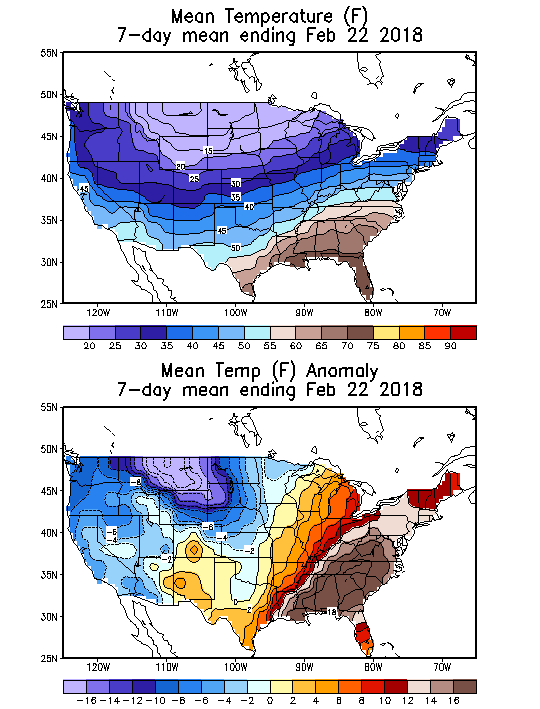
Source: NOAA National Weather Service
Deviation between average and normal (°F)
7-Day Mean ending Feb 22, 2018

Source: NOAA National Weather Service

